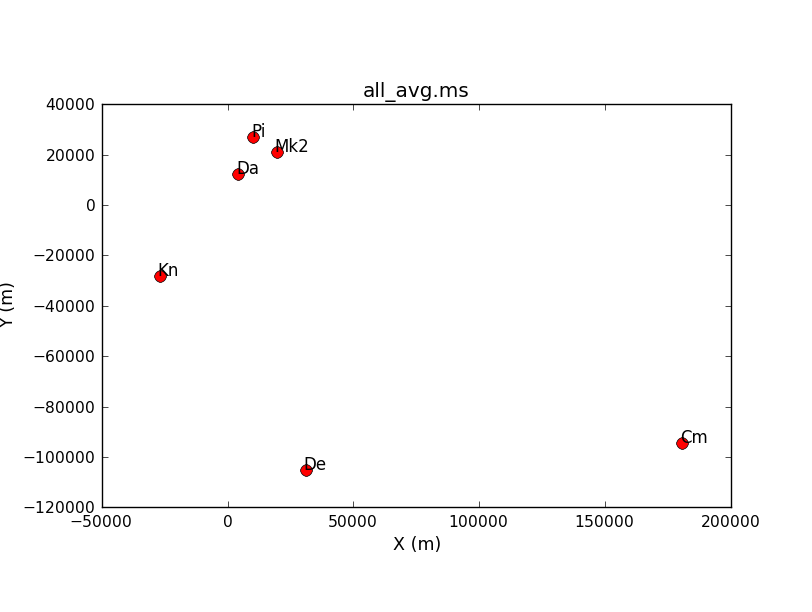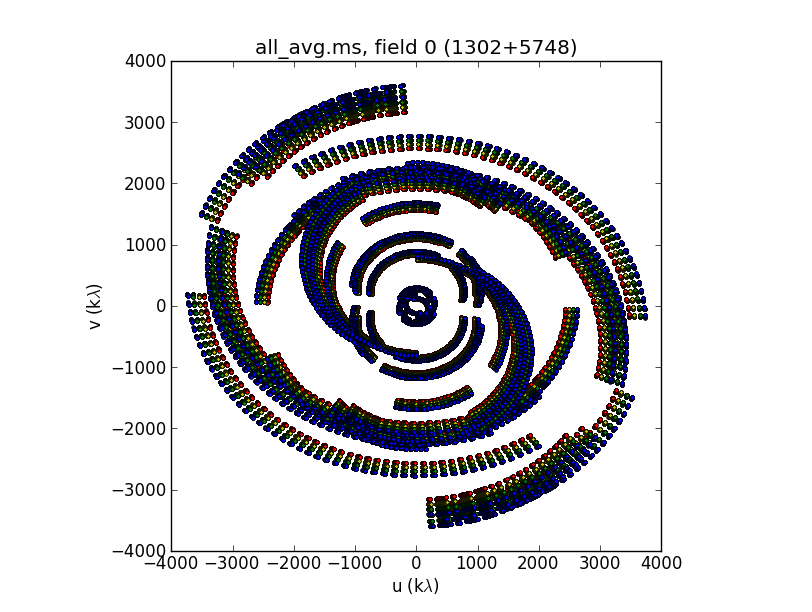Part 1: 3C277.1 flagging
« Return to homepage
« Return to eMERLIN Workshop
3C277.1 is a twin-lobed radio galaxy. These C-band (4-7.3 GHz) e-MERLIN observations were made specifically for this tutorial but previous MERLIN and VLA images have been published by Ludke et al. 1998 and Cotton et al. 2006.
Data required and pre-processing
The data have already been converted from fitsidi to a Measurement Set (MS), and preparatory steps such as correcting the uv coordinates and averaging have been performed. You need to have:
- all_avg.ms.tar (1.6 G plus another 1.6 G to extract it).
- 3C277.1_flag_skeleton.py: script equivalent of the guide
- 3C277.1_flag_all.py.gz: compressed version for reference if you get stuck
- all_avg_1.flags: list of flags
- Check data: listobs and plotants (step 1)
- Identify ‘late on source’ bad data (step 2)
- Flag the bad data at the start of each scan (step 3)
- Flag the bad end channels (step 4)
- Identify and flag remaining bad data (step 5)
The task names are given below. You need to fill in one or more parameters and values where you see ***. Use the help in CASA, e.g. for flagdata
taskhelp # list all tasks
inp(flagdata) # possible inputs to task
help(flagdata) # help for task
help(par.mode) # help for a particular input (only for some parameters)
Check data: listobs and plotants (step 1)
-
Check that you have
all_avg.msin a directory with enough space and start CASA. -
Enter the parameter to specify the MS and, optionally, the parameter to write the listing to a text file.
# in CASA
listobs(***)
Because e-MERLIN stores data for each source in a separate fitsidi file, the sources are listed one by one even though the phase-ref and target scans interleave. So selected entries from listobs, re-ordered by time, show:
Timerange (UTC) Scan FldId FieldName nRows
SpwIds Average Interval(s) #(i.e. RR RL LR LL integration time)
05-May-2015
...
20:02:08.0 - 20:05:08.5 7 0 1302+5748 2760
[0,1,2,3] [3.91, 3.91, 3.91, 3.91] # phase-ref
20:05:11.0 - 20:12:33.5 72 1 1252+5634 6660
[0,1,2,3] [3.98, 3.98, 3.98, 3.98] # target
20:12:36.0 - 20:15:34.5 8 0 1302+5748 2700
[0,1,2,3] [3.96, 3.96, 3.96, 3.96] # phase-ref
...
22:02:04.0 - 22:47:00.5 132 2 1331+305 40500 [0,
1, 2, 3] [3.99, 3.99, 3.99, 3.99] # flux scale/pol angle calibrator
22:47:03.0 - 23:29:59.5 133 3 1407+284 38700 [0,
1, 2, 3] [3.99, 3.99, 3.99, 3.99] # bandpass calibrator
06-May-2015
07:30:03.0 - 08:29:59.5 134 4 0319+415 54000 [0,
1, 2, 3] [4, 4, 4, 4] # bandpass/leakage calibrator
There are 4 spw:
SpwID Name #Chans Frame Ch0(MHz) ChanWid(kHz) TotBW(kHz) CtrFreq(MHz) Corrs
0 none 64 TOPO 4817.000 2000.000 128000.0 4880.0000 RR RL LR LL
1 none 64 TOPO 4945.000 2000.000 128000.0 5008.0000 RR RL LR LL
2 none 64 TOPO 5073.000 2000.000 128000.0 5136.0000 RR RL LR LL
3 none 64 TOPO 5201.000 2000.000 128000.0 5264.0000 RR RL LR LL
And 6 antennas:
ID Name Station Diam. Long. Lat. ITRF Geocentric coordinates (m)
0 Mk2 e-MERLIN:02 24.0 m -002.18.08.9 +53.02.58.7 3822473.365000 -153692.318000 5085851.303000
1 Kn e-MERLIN:05 25.0 m -002.59.44.9 +52.36.18.4 3859711.503000 -201995.077000 5056134.251000
2 De e-MERLIN:06 25.0 m -002.08.35.0 +51.54.50.9 3923069.171000 -146804.368000 5009320.528000
3 Pi e-MERLIN:07 25.0 m -002.26.38.3 +53.06.16.2 3817176.561000 -162921.179000 5089462.057000
4 Da e-MERLIN:08 25.0 m -002.32.03.3 +52.58.18.5 3828714.513000 -169458.995000 5080647.749000
5 Cm e-MERLIN:09 32.0 m +000.02.19.5 +51.58.50.2 3919982.752000 2651.982000 5013849.826000
- Enter one parameter to plot the antenna positions (optionally, a second to write this to a png).
plotants(***)

Consider what would make a good reference antenna. Although Cambridge has the largest diameter, it has no short baselines.
- Plot the uv coverage of the data for the phase-reference source.
See annotated listobs output above to identify this. You need to enter several parameters; some have been done for you:
# in CASA
plotuv(vis='***',
field='***', # phase-ref
maxnpts=10000000, # to plot all the data
symbol='.', # a dot which will have a different colour for each spw
figfile='') # fill this in if you want a png
The u and v coordinates represent (wavelength/projected baseline) as the Earth rotates whilst the source is observed. Thus, as each spw is at a different wavelength, it samples a different part of the uv plane, improving the aperture coverage of the source, allowing Multi-Frequency Synthesis (MFS) of continuum sources.
